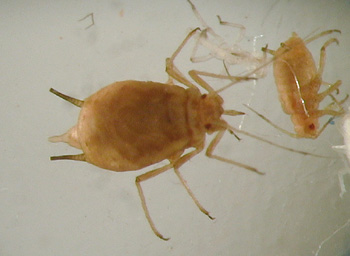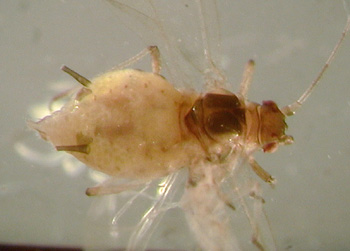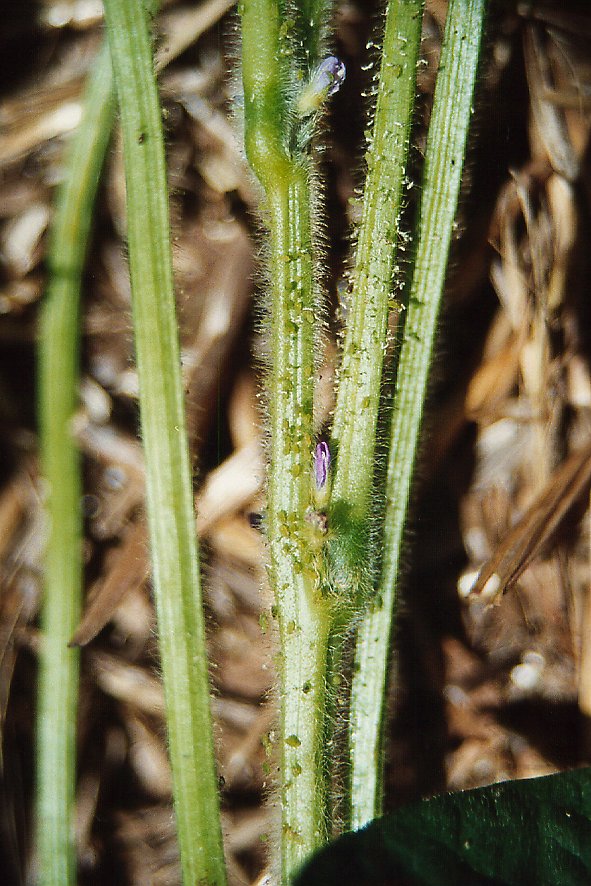
Soybean aphid
| Primefact number | Edition | Published | Author |
|---|---|---|---|
| 1631 | First | Mar 2018 | Murray J. Fletcher, Peter Desborough |


Scientific name: Aphis glycines Matsumura (Hemiptera: Aphididae)
Common names: Soybean aphid, soya bean aphid
Notifiable status
Soybean aphid (Aphis glycines) is not a notifiable plant pest in NSW
A full list of notifiable plant pests and diseases can be found in Schedule 2 of the NSW Biosecurity Act 2015.
Identification
The soybean aphid is a small aphid, pale yellow in life, with black siphunculi and pale cauda (figure 3). No other aphid living on soybeans has the same combination of size and colour. Other species of aphids on legumes that might be confused with it are Aphis gossypii (the cotton aphid) which has a shorter, dark cauda and Aphis craccivora (the cowpea aphid) which has a black patch on the back of the wingless adults.
Known hosts
In Australia, the aphid has so far only been found on soybeans.
In China and Japan, the soybean aphid alternates between Rhamnus species (Family Rhamnaceae) and certain legumes, mainly soybean and species of Glycine but also recorded from species of Pueraria and Desmodium (Blackman et al. 1997).
Damage
A. glycines is capable of causing significant reduction in growth and seed production in soybeans. A study by Wang et al. (1996) in China found that seed yields were reduced by 27.8% and plant height decreased by 20.2 cm in infested plants as compared with the control.
The soybean aphid is a known vector of a number of plant virus diseases, including abaca mosaic, soyabean mosaic, soyabean stunt, beet mosaic, millet red leaf, mungbean mosaic, bean yellow mosaic and Indonesian soybean dwarf. A. glycines has been found to transmit peanut mottle virus in ground nuts in Indonesia.
In Australia experience with soybean aphid is very new. Known infestations in crops observed are distributed sporadically through a paddock and in quite small areas (1m2). Thus they can be difficult to detect. Plant damage is in the form of leaf distortion (where very dense aphid populations occur) and severe vigour loss.
Lifecycle
The life cycle is described in Japan by Takahashi et al (1993) and in China by Wang, et al. (1962). Studies undertaken in Taiwan, Korea and Japan indicate that the optimum temperatures for the aphid are 20-24°C (see Hirano, et al. 1996). Aphid densities peak in the vegetative plant stage and decline rapidly afterwards or towards the flowering stage.
Natural enemies
Predators include hoverfly larvae (Family Syrphidae) and ladybird larvae (Family Coccinellidae) which have been shown to play a role in suppression of A. glycines populations in soybeans (Berg, et al. 1997).
A number of parasitoids are known to be effective in helping to control numbers of the aphid. The braconid wasps Aphidius cingulatus, Ephedrus persicae and Ephedrus plagiator are effective primary parasitoids in Korea (Chang et al. 1994). Wang and Ba (1998) reviewed options for cultural and biological control of A. glycines.
Distribution
In Australia, the species has been found in NSW and Queensland. In NSW this includes the North Coast, Northern Tablelands and Forbes in the Central West. In Queensland, soybean aphid has been found in most soybean areas from Bundaberg to SE Queensland, including the Darling Downs.
Overseas it is found in China, Japan, far eastern Russia, Korea, Thailand, Borneo, Malaya, the Philippines, and Indonesia.
References
Berg, H. van den, Ankasah, D., Muhammad, A., Rusli, R., Widayanto, H.A., Wirasto, H.B., and Yully, I. (1997) Evaluating the role of predation in population fluctuations of the soybean aphid Aphis glycines in farmers' fields in Indonesia. Journal of Applied Ecology.34(4): 971-984.
Blackman, R.L., Eastop, V.F. and Kibby, G.G. (1997) "Taxakey: Aphids on the World's Crops." CD-ROM. CAB International & The Natural History Museum. ISBN 0 85199 172 6
Chang,Y.D., Lee, J.Y. and Youn, Y.N. (1994) Primary parasitoids and hyperparasitoids of the soyabean aphid, Aphis glycines (Homoptera: Aphididae). Korean Journal of Applied Entomology 33(2): 51-55
Hirano, H., Honda, K.I. and Miyai, S. (1996) Effects of temperature on development, longevity and reproduction of the soybean aphid, Aphis glycines (Homoptera: Aphididae). Applied Entomology and Zoology. 31(1): 178-180.
Takahashi, S., Inaizumi, M. and Kawakami, K. (1993) Life cycle of the soyabean aphid Aphis glycines Matsumura, in Japan. Japanese Journal of Applied Entomology and Zoology.37(4): 207-212.
Wang, C.L., Siang, N.I., Chang, G.S. and Chu, H.F. (1962) Studies on the soybean aphid Aphis glycines Matsumura. Acta entomologica Sinica 11: 31-44.
Wang, S.Y., Bao, X.Z., Sun Y.J., Chen, R.L. and Zhai, B.P. (1996) Study on the effects of the population dynamics of soyabean aphid (Aphis glycines) on both growth and yield of soyabean. Soybean Science. 15(3): 243-247.
Wang, Y.Z. and Ba, F. (1998) Study on the optimum control of soybean aphid. Acta Phytophylactica Sinica. 25(2): 151-155.
Acknowledgements
Dr Victor Eastop, of the Natural History Museum, London, has given valuable advice on the identification of A. glycines.


